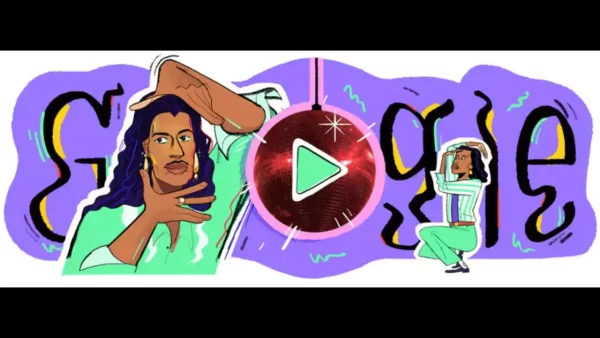
Exploring Today’s Google Doodle Honoring the Dance Icon Willi Ninja
The Google Doodle showcased on this day pays tribute to the renowned American dancer, William Roscoe Leake, famously known as Willi Ninja. As an emblematic figure in the ballroom scene, Willi Ninja not only left an indelible mark on the world of dance but also became a powerful symbol of LGBTQ representation. On June 9, we commemorate the 33rd anniversary of the 1990 documentary that showcased Willi Ninja’s extraordinary talent and the vibrant community he fostered, particularly for Black and Latino individuals.
Today, Google dedicates a special Google Doodle in commemoration of William Roscoe Leake, famously known as Willi Ninja, an American dancer and iconic figure in the world of ballroom. This tribute coincides with the release of the influential 1990 documentary “Paris is Burning” at the NewFest New York LGBT Film Festival.
Describing Willi Ninja as the “Godfather of Voguing,” Google highlights his remarkable contributions as a dancer and choreographer, particularly in paving the way for Black LGBTQ+ representation and acceptance during the 1980s and ’90s. The legacy of the community he established, known as “The Iconic House of Ninja,” continues to thrive today.
In this interactive Google Doodle, specially designed for Pride Month, the spotlight is on the film featuring Willi and the Iconic House of Ninja. It showcases his dynamic dance moves, which not only influenced the drag scene in New York but also inspired artists like Madonna and designer Jean-Paul Gaultier.
Born on April 12, 1961, in Flushing, Queens, Willi was fortunate to have a supportive mother who embraced his identity and nurtured his passion for dance by taking him to ballet performances.
Willi Ninja revolutionized the voguing landscape with his innovative dance techniques, drawing inspiration from Egyptian hieroglyphs and martial arts, propelling him to fame in the 1990s. He graced the screens of films, music videos, and fashion shows around the world.
Aside from his dancing prowess, Willi Ninja was also a powerful advocate for his community. The Google Doodle description highlights his early efforts to raise awareness about HIV/AIDS prevention at drag balls, playing a pivotal role in reducing the stigma associated with the disease.
Furthermore, Willi is credited with founding his own collective, the House of Ninja, in 1982. Such groups serve as an extended social family and support system for many Black and Latino dancers who experience rejection from their own families.
Google concludes its tribute with gratitude, thanking Willi Ninja for his invaluable contributions to the world of dance and for bringing visibility to Black and Latino LGBTQ+ identities worldwide. The House of Ninja continues to dance in his honor.
Who is Willi Ninja?
Willi Ninja was an iconic American dancer, choreographer, and voguing pioneer. Born as William Roscoe Leake on April 12, 1961, in Flushing, Queens, New York, he gained international recognition for his contributions to the ballroom scene and LGBTQ+ representation. Willi Ninja’s dynamic dance style, drawing inspiration from Egyptian hieroglyphs and martial arts, captivated audiences with its precision and athleticism. He became widely known as the “Godfather of Voguing” and played a significant role in popularizing the dance form in the 1980s and ’90s. Willi Ninja’s fame skyrocketed with his appearance in the groundbreaking documentary “Paris is Burning” (1990), which shed light on the vibrant ballroom culture and LGBTQ+ community. He not only influenced the drag and fashion industry but also inspired artists like Madonna and designer Jean-Paul Gaultier. Throughout his career, Willi Ninja advocated for Black LGBTQ+ representation and worked towards reducing the stigma surrounding HIV/AIDS. He founded his own collective called the House of Ninja in 1982, creating a supportive and inclusive space for dancers. Willi Ninja’s legacy as a dance pioneer and his impact on cultural acceptance continue to inspire and influence generations of dancers and performers worldwide.
Personal Information about Willi Ninja:
Ful Name: William Roscoe Leake (known as Willi Ninja)
Date of Birth: April 12, 1961
Place of Birth: Flushing, Queens, New York, United States
25 interesting facts about Dancer Willi Ninja
- Willi Ninja’s real name was William Roscoe Leake, but he became widely known as Willi Ninja in the dance community.
- He was born on April 12, 1961, in Flushing, Queens, New York.
- Willi Ninja’s mother was supportive of his passion for dance and encouraged him by taking him to ballet performances.
- He gained prominence as a dancer and choreographer in the ballroom scene, particularly in the voguing style.
- Willi Ninja was considered the “Godfather of Voguing” due to his significant influence on the dance style.
- He was one of the leading figures in the development and popularization of voguing in the 1980s and ’90s.
- Willi Ninja’s dance style drew inspiration from a diverse range of sources, including Egyptian hieroglyphs and martial arts.
- He was known for his dynamic and precise moves, captivating audiences with his unique blend of athleticism and grace.
- Willi Ninja’s talents and creativity extended beyond dancing, as he was also skilled in choreography and runway modeling.
- He became internationally recognized through his appearances in films, music videos, and fashion shows around the world.
- Willi Ninja’s most notable appearance was in the acclaimed 1990 documentary “Paris is Burning,” which showcased the vibrant ballroom culture in New York City.
- The documentary propelled him to greater fame and brought attention to the LGBTQ+ community and voguing as an art form.
- Willi Ninja’s influence on the drag and fashion industry was immense, with renowned artists like Madonna and designer Jean-Paul Gaultier drawing inspiration from him.
- He played a pivotal role in promoting Black LGBTQ+ representation and acceptance during the ’80s and ’90s.
- Willi Ninja’s advocacy extended to raising awareness about HIV/AIDS prevention, particularly within the drag ball community.
- He established his own collective called the House of Ninja in 1982, providing a supportive and inclusive space for Black and Latino dancers.
- The House of Ninja became an influential force within the ballroom scene and continues to thrive to this day.
- Willi Ninja’s legacy as a dance pioneer paved the way for future generations of LGBTQ+ dancers and performers.
- He broke barriers and shattered stereotypes, challenging societal norms with his unapologetic self-expression through dance.
- Willi Ninja’s contributions to the world of dance were recognized with numerous awards and accolades.
- He remains an iconic figure in the LGBTQ+ community, celebrated for his artistry, activism, and resilience.
- Willi Ninja’s life and achievements continue to inspire dancers and artists around the world.
- Despite facing adversity and discrimination, he remained dedicated to his craft, using dance as a form of empowerment and self-assertion.
- Willi Ninja’s passion for voguing and his determination to succeed helped him leave an indelible mark on the dance world.
- His impact on dance, LGBTQ+ representation, and cultural acceptance continues to resonate, making him an enduring legend in the history of dance.



